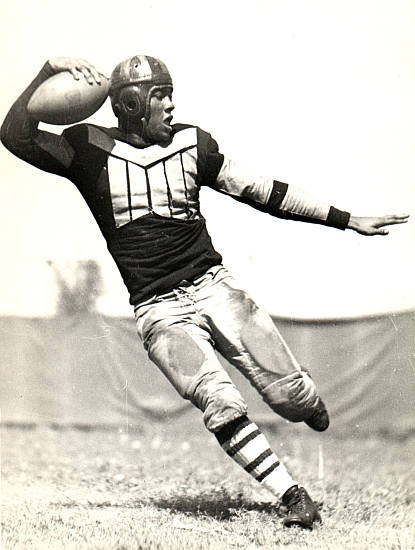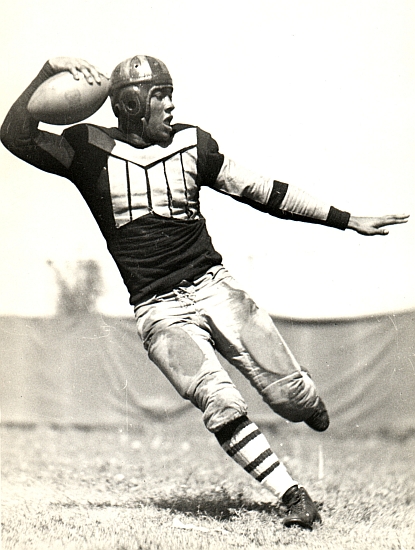
The Iowa–Minnesota football rivalry is an intense American college football rivalry between the Iowa Hawkeyes football team of the University of Iowa and Minnesota Golden Gophers football team of the University of Minnesota. The Floyd of Rosedale, introduced in 1935, is a bronze trophy in the shape of a pig which is awarded to the winner of the game.
Ozzie Simmons is probably best known as the central figure in the story that spawned the Floyd of Rosedale trophy given to the winnder of the Iowa-Minnesota rivalry game. Nicknamed the “Ebony Eel”, Simmons was one of the first black All-American football players in the 1930s.

As a talented black player in the 1930s, Simmons was a target of opposing players, which accounted for many of his numerous injuries. During a run against Northwestern University, he was punched. In another game, a newspaper account says a player “rammed his locked hands into Simmons’ face.”
Ronald Reagan, then a radio sportscaster in Des Moines and later the 40th president of the United States, said, “The problems were when you played another team that did not have a black. For some reason or another, then they would pick on this one man.” Reagan then recounted a game against Illinois when Ozzie was injured twice. Reagan said, “I saw (Iowa players) Dick Crayne and Ted Osmaloski walk over to the Illinois huddle during a timeout, and after the game I found out…they said, ‘Do that to (Simmons) once more, and we’re going to run you right out of the end of your stadium.'”
But the worst treatment for Ozzie came in the 1934 game against Minnesota. Just 12 years earlier, Iowa State‘s first black player, Jack Trice, was killed by injuries sustained in a game against the Gophers. In 1934, Simmons was knocked out of the Minnesota game three times due to injuries. Simmons did not play in the second half in a blowout Gopher win. “The Minnesota game was the most blatant attack. They were blatant with their piling on and kneeing me. It was obvious, but the refs didn’t call it. Some of our fans wanted to come out on the field,” Simmons said in 1989.
Minnesota displayed much discrimination against black students in the 1930s. The men’s dormitory was segregated and the school maintained as a white-only space. The women’s dormitories were maintained as white-only spaces too. The University of Minnesota also maintained a white-only nursing program. Also dances were to be racially pure at the University of Minnesota and the University employees were white only.
Racism was a distant argument for the all-white Gopher players as they buy viagra online with prescription prepared for a rematch with Iowa on a November day in 1935. They were immersed in football and one player was on their mind; Ozzie Simmons one of the great stars of Iowa.
The following year, Minnesota was scheduled to play at Iowa. While talking to a reporter, Iowa’s governor stated, “If the officials stand for any rough tactics like Minnesota used last year, I’m sure the crowd won’t.” Minnesota’s coach Bernie Bierman requested extra security for his team, and tensions were high. To defuse the situation, Minnesota’s governor wagered Iowa’s governor a prize hog that the Gophers would win the game.

Minnesota did win a clean, fair game in 1935 that was played without incident. Iowa’s governor obtained the pig from Rosedale Farms and named him Floyd after Minnesota’s governor. Minnesota’s governor had a bronze replica made of “Floyd of Rosedale“, and Iowa and Minnesota have played for the trophy every year since 1935.
Later Life
Ozzie Simmons lettered at Iowa from 1934–1936, and his brother Don Simmons lettered as an end in 1935 and 1936. Black players were not allowed in the NFL at the time, and Ozzie Simmons played only two years professionally. Simmons played for the Patterson Panthers of the all-black American Association in 1937 and 1939. He was a second team all-league player in 1937 and a first team all-league player in 1939.
Simmons later became a physical education teacher in the Chicago public school system. He and his wife, Eutopia Morsell, married in 1960 and lived in Chicago, where she was part-owner of a funeral home. Ozzie retired from teaching in 1979 after 38 years, and then worked with his wife. He died in 2001 from complications from Alzheimer’s and Parkinson’s diseases.
Simmons was inducted into the Bob Douglas Black Sports Hall of Fame in New York in 1984. In 1989, Iowa fans selected an all-time University of Iowa football team during the 100th anniversary celebration of Iowa football, and Ozzie Simmons was selected to the team as a running back.
Simmons said he never took much interest in the Floyd of Rosedale trophy because of the racial era it recalled. The Floyd of Rosedale trophy is about football, a celebrated college rivalry and it’s also about American racial history. It began in an era when racial discrimination was widespread, and protected at the highest levels of government. All Simmons wanted was a chance. The trophy is an ever-present reminder of how precious that right is.
